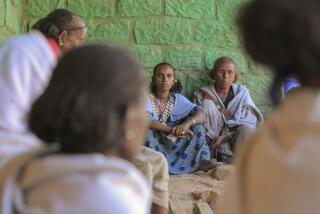Mule Gridlock a Sign of Reforms at Work : Ethiopia: There are indications that change in this once rigidly communist country may have begun to improve both food production and transport.
- Share via
ADDIS ABABA, Ethiopia — It was a traffic jam, Ethiopian-style. A mule train brought movement to a standstill outside the central market last month as the animals, loaded with grain, vied for space with trucks bringing in corn and teff, a local cereal.
It was a sign, perhaps, that agriculture reforms may finally be working in a country so prone to famine.
Less than a year after President Mengistu Haile Mariam freed farmers from state controls, there are indications that change in this once rigidly communist country may have begun to improve both food production and transport.
But experts are cautious about raising hopes in a nation where millions face famine again in 1991 unless massive foreign food aid reaches the war-torn and drought-hit north.
In Ethiopia, more starkly than in many African states, past failures in economic policy have been a matter of life and death.
“We have some hope that the (1990 grain) deficit will be somewhat smaller” than in 1989, said Ingo Loerbroks, representative of the United Nations’ Food and Agriculture Organization.
“But it really is too early to say,” he said.
Mengistu announced early last March that he would abandon 15 years of socialist policies in agriculture as part of a major shift toward a mixed economy.
A government quota system, which paid farmers below market rates, was abolished, controls on grain movement were lifted and peasants were allowed to earn money working on the farms of others.
While the state continues to own all rural land, Mengistu said peasants would have increased legal rights over the soil they tilled and could leave farms to their heirs.
The aim was to reverse a decline in agricultural production that averaged 1.1% a year during most of the last decade, according to the latest World Bank data.
Experts say it is too early to measure the effect of reform on national output but they noted that prices quickly reacted.
After an initial fall--apparently as hoarded stocks were sold--grain prices rallied as subsidized supplies vanished and demand pushed up the amount farmers could charge.
By September grain prices were 18% higher in Addis Ababa than a year before, according to government data.
Government officials and Western agencies backing the reform say some producers are responding to the greater price incentive by planting more crops and selling the surplus.
“Farmers at the moment are getting better prices, so they are producing more,” said Deputy Prime Minister Wollie Chekol, who has responsibility for economic policy.
“But to quantify (long-term effects) will take a year or two. We’ve not completed one harvest year,” he said.
Critics, however, see little hope that farm reforms can narrow the nation’s chronic food gap amid civil war and political hostility to the government. Transport is in crisis, and investment low.
Even supporters see problems. Land tenure rights are vague, a potential flash point for violent rivalry over the best land, and big government reforestation projects--vital to stop soil erosion--are at risk as central planning wanes.
But some Western farm experts said news of the reforms was celebrated by the peasant farmers who are the backbone of this impoverished economy, accounting for more than 80% of employment.
Thousands of producer cooperatives--an unpopular system of collective farming--spontaneously dissolved or were abandoned.
“The collapse of producer cooperatives . . . had a great effect on morale,” said one Western expert. “It was symbolic that this great model (of socialist farming) was seen to be a failure.”
In the breadbasket areas of Shoa and Arsi, some peasants are said to have planted 10% to 20% more land in 1990 than in 1989, raising expectations for the harvest currently being gathered.
“We’re expecting a pretty good harvest, possibly a record harvest in Shoa,” said James Moran, a European Community agricultural adviser.
Experts agree, however, that even such increased acreages cannot compensate for huge grain deficits elsewhere, notably in the war zones of Eritrea and Tigray.
Fighting between rebels and government forces, combined with drought in these two northern regions, means that 4.3 million people face famine in 1991, the government says.
“Drought is one problem but the major problem is man-made,” said Relief and Rehabilitation Commissioner Yilma Kassaye. “Where fighting takes place there cannot be any grain.”
Soil erosion and population growth of 3% a year add to the problem of feeding Ethiopia’s estimated 52 million people, who make it Africa’s second most populous nation.
“Every year this country needs to produce around 350,000 tons more grain to feed the additional 1.5 million people,” noted the U.N.’s Loerbroks.
He said that to meet the food challenge Ethiopia requires not just better price incentives for farmers, but investment to expand the total area under cultivation and to pay for irrigation projects, fertilizers and better farming methods.
But without Western capital to pay for such projects--largely withheld by donors who say Mengistu spends too much on defense to develop one of the world’s poorest economies--many Ethiopians look set to remain dependent on Western food aid.
More to Read
Sign up for Essential California
The most important California stories and recommendations in your inbox every morning.
You may occasionally receive promotional content from the Los Angeles Times.













